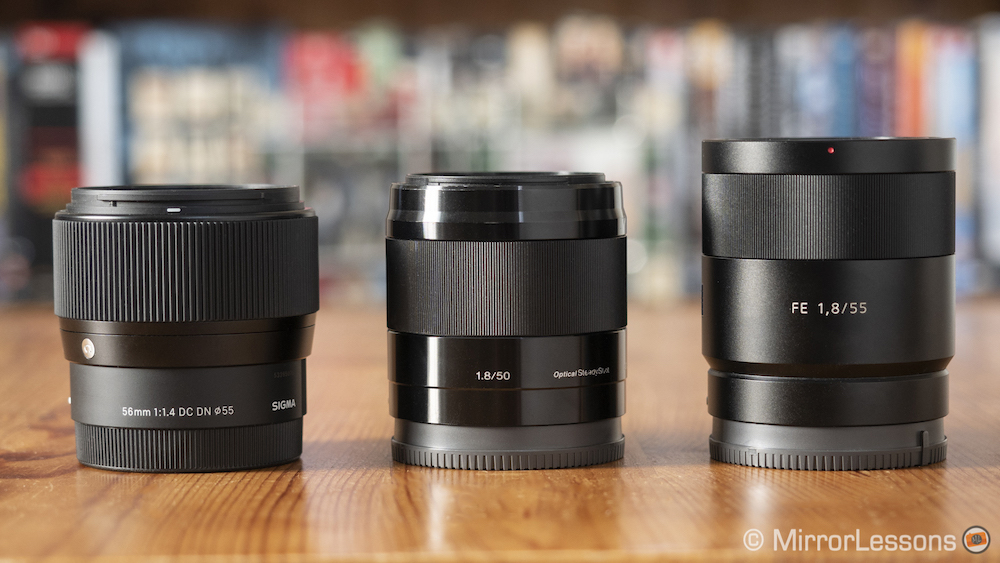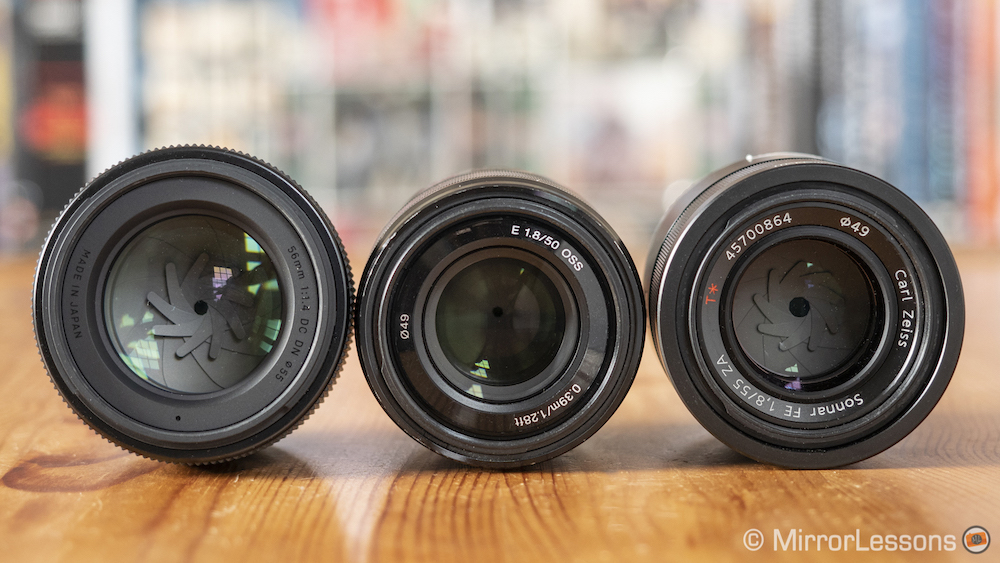The Sigma 56mm f/1.4 DC DN Contemporary is the latest prime to join Sony’s range of APS-C E-mount lenses. With an equivalent coverage of 84mm in 35mm terms and a very fast 1.4 maximum aperture, it has all the characteristics you’d expect from a portrait lens, making it a very desirable product for Sony users.
Within the Sony E-mount range, there are already quite a few lenses with an equivalent 70-85mm focal length, two of which are the E 50mm f/1.8 OSS (75mm equivalent) and the FE 55mm f/1.8 ZA (82.5mm equivalent). In this comparison, we’re going to be taking a look at how these three primes compare.
Ethics statement: We bought the two Sony lenses for our personal use whereas the Sigma 56mm f/1.4 was loaned to us for three weeks. We were not asked to write anything about these products, nor were we provided with any sort of compensation. Within the article, there are affiliate links. If you buy something after clicking the link, we will receive a small commission. To know more about our ethics, you can visit our full disclosure page. Thank you!
[toc heading_levels=”2″]
Main Specifications
Sigma 56mm f/1.4 DC DN
- Mount: E-mount
- Format: APS-C
- Focal length: 56mm
- Lens configuration: 10 elements in 6 groups
- Lens coating: Super Multi-Layer Coating
- Angle of view: 28.5°
- Minimum focusing distance: 50cm
- Magnification: 0.135x
- Aperture blades: 9 circular blades
- Aperture range: 1.4 to 16
- Filter diameter: 55mm
- Weather-sealing: Dust and moisture sealed mount
- Optical stabilisation: No
- Dimensions: 66.5 x 59.5mm
- Weight: 280g
Sony E 50mm f/1.8 OSS
- Mount: E-mount
- Format: APS-C
- Focal length: 50mm
- Lens configuration: 9 elements in 8 groups
- Lens coating: N/A
- Angle of view: 32°
- Minimum focusing distance: 39cm
- Magnification: 0.16x
- Aperture blades: 7 circular blades
- Aperture range: 1.8 to 22
- Filter diameter: 49mm
- Weather-sealing: No
- Optical stabilisation: Yes (Optical SteadyShot)
- Dimensions: 62 x 62mm
- Weight: 202g
Sony FE 55mm f/1.8
- Mount: E-mount
- Format: 35mm
- Focal length: 55mm
- Lens configuration: 5 elements in 7 groups
- Lens coating: ZEISS T* coating
- Angle of view: 43° (full-frame), 29° (APS-C)
- Minimum focus distance: 50cm
- Magnification: 0.14x
- Aperture blades: 9 circular blades
- Aperture range: 1.8 – 22
- Filter diameter: 49mm
- Weather-sealing: Yes
- Optical stabilisation: No
- Weight: 281g
- Dimensions: 64.4 x 70.5mm
Design and ease of use
Looking at the three E-Mount lenses side-by-side, we can see that although the 55mm is a little taller than the other two, and the Sigma is a little chunkier around the middle where the focus ring is, they are all more or less the same size.
The 55mm and 56mm are almost the same weight (281g vs 280g respectively) whereas the 50mm is the lightest of the three at just 202g. All three are a good match for Sony E-mount cameras such as the a6300 pictured below.
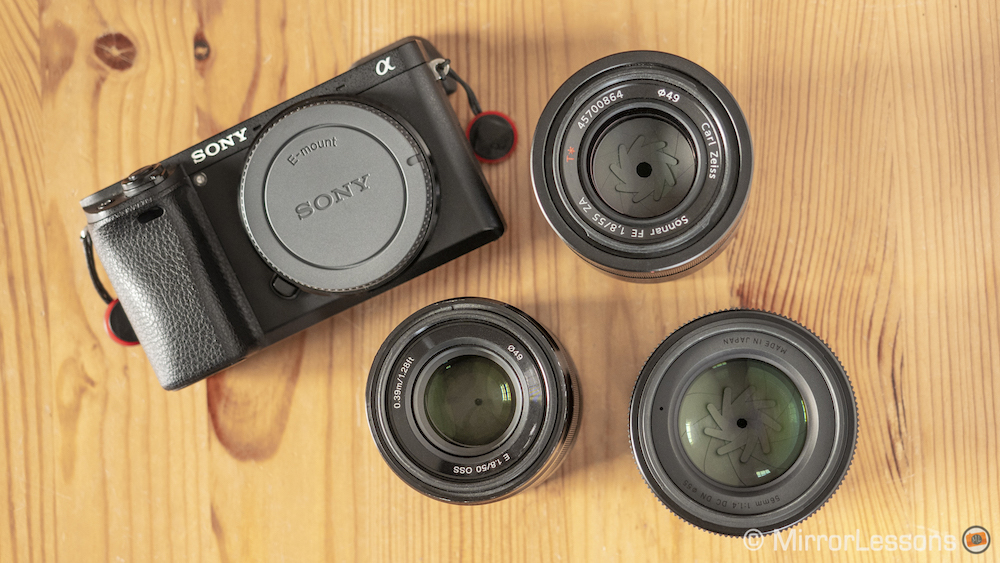
The 50mm is made from high quality plastics but features an external metal finish, whereas the 55mm and 56mm are both predominantly metal – hence the additional weight. The only non-metallic part of the 56mm is the rubber focus ring. All three come with a metal mount.
The 55mm features a dust and moisture resistant design. The 56mm is only protected around the mount thanks to the rubber sealing. The 50mm doesn’t feature any weather-resistance whatsoever.
Each lens has a filter thread at the front to which you can attach ND filters. The diameter is the same for the two Sony lenses (49mm) whereas the Sigma accepts 55mm filters.
A plastic lens hood is provided with all three lenses. (My second-hand copy of the 50mm didn’t come with one unfortunately, which is why it isn’t pictured below.)
The only lens to come in either black or silver is the 50mm. The other two are only available in black.
Optical quality – Through the lens
Sharpness
First let’s take a look at how centre sharpness compares at a distance of approximately 7 meters.
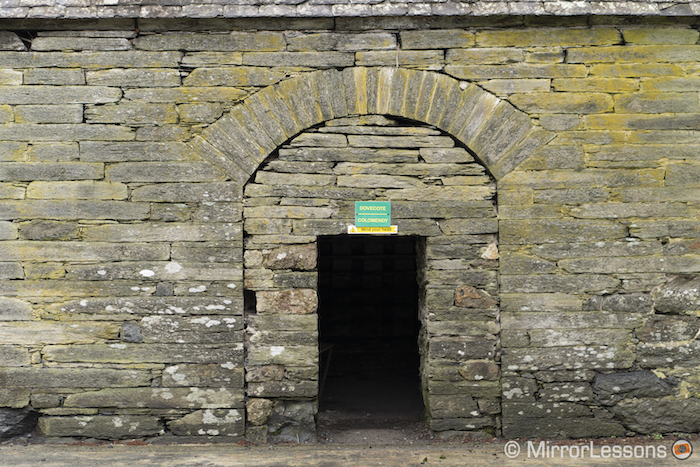
At their fastest apertures, the 50mm is clearly the softest of the three. The 55mm and 56mm look very similar but if I had to choose, I would say the 55mm was ever so slightly sharper.
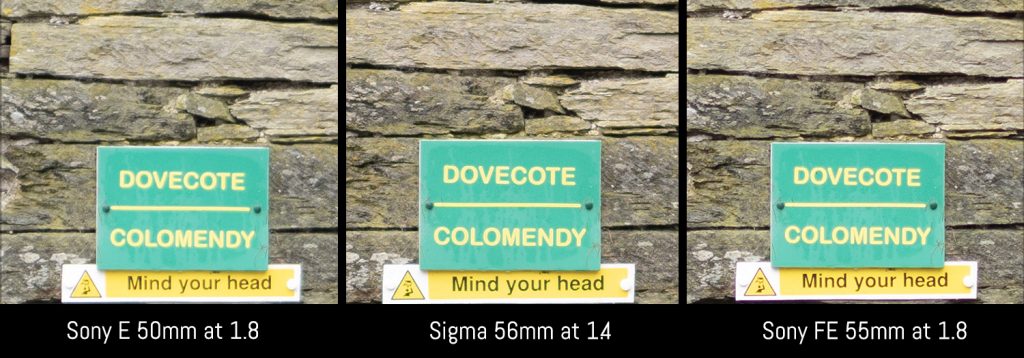
Stop them down to the first aperture value they share – f/2 – and the Sigma suddenly springs into the lead.

At f/2.8, the Sigma continues to be sharper than the 55mm but only just. At this point, the 50mm starts to improve but it doesn’t quite match either of its rivals.
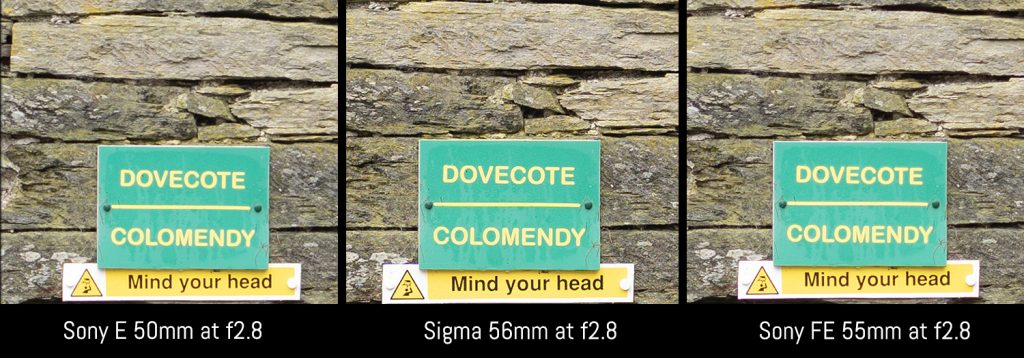
At f/4 and beyond, it is very difficult to tell the difference between the three lenses, although I would say the 50mm is still marginally softer than both the 55mm and 56mm.
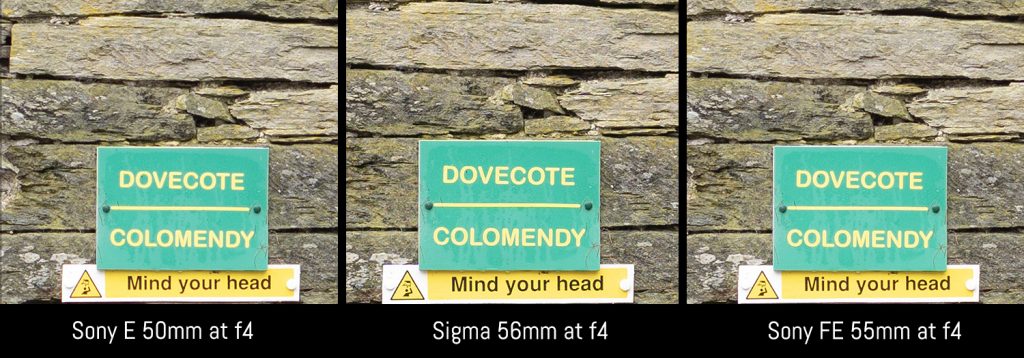
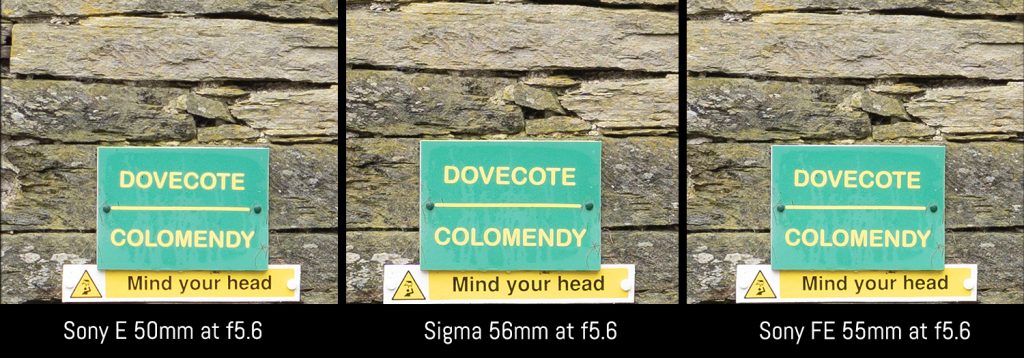
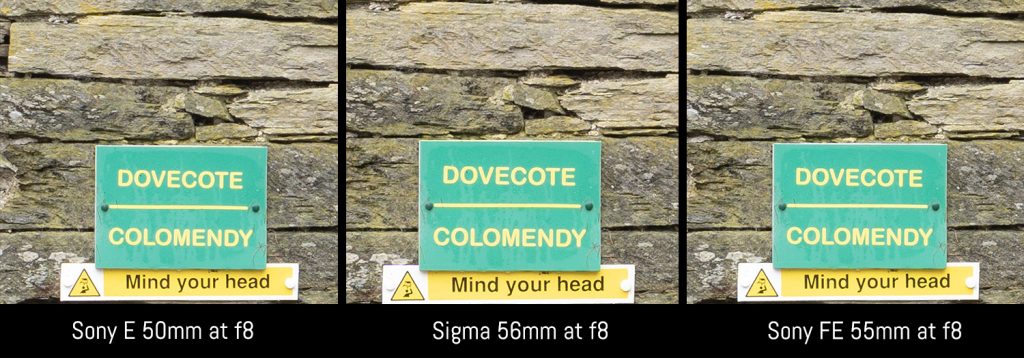
At f/11, diffraction starts to inhibit lens resolution and by f/16, they all appear quite soft.
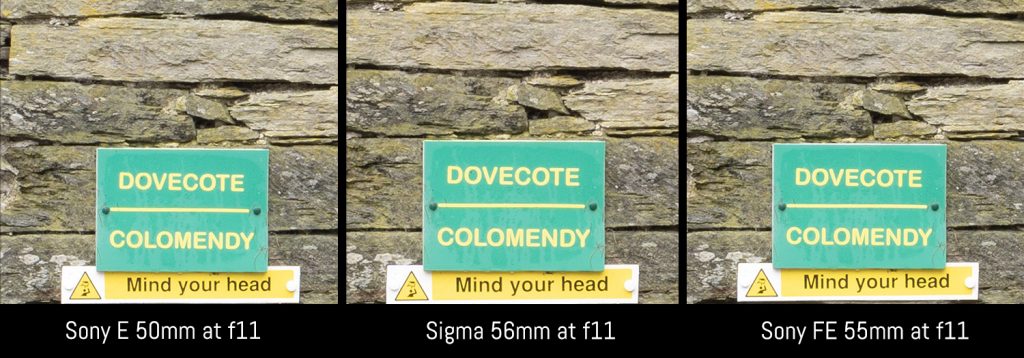
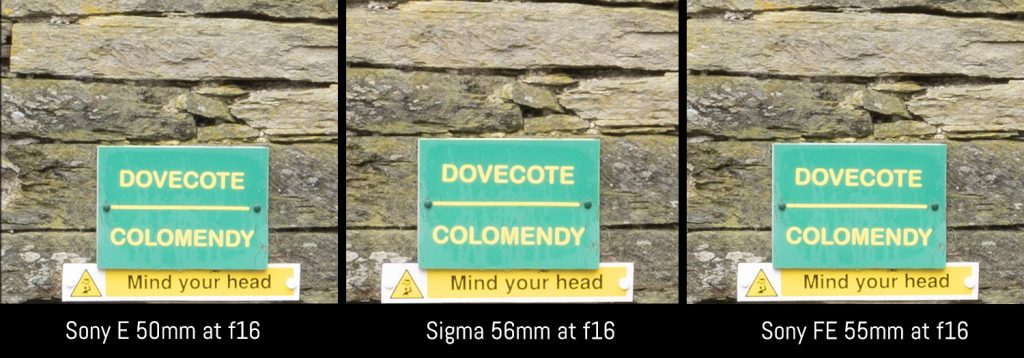
The ‘sweet spot’ for the 55mm and 56mm is anywhere between f/2.8 and f/5.6. The 50mm performs best between f/4 and f/5.6.
In the corners, the 55mm appears to have an advantage over both the 50mm and 56mm wide open.
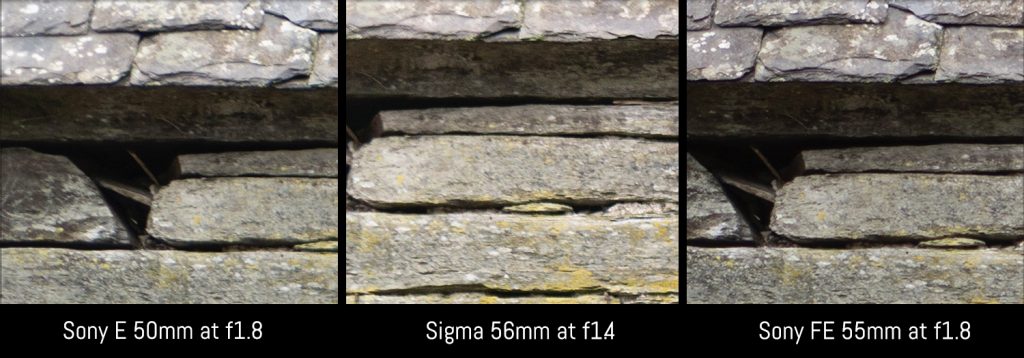
It doesn’t take long for the Sigma to sharpen up however: by f/2.8 it looks identical to the 55mm. The 50mm remains the softest of the three.
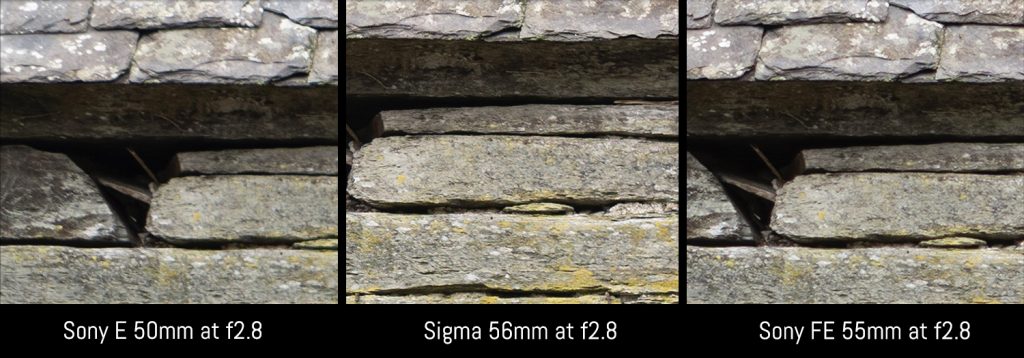
At f/5.6 and beyond, the results look very similar once again. The 55mm and 56mm are still a tad sharper than the 50mm but the differences are barely worth mentioning. The best corner results are found at around f/5.6 with all three lenses.
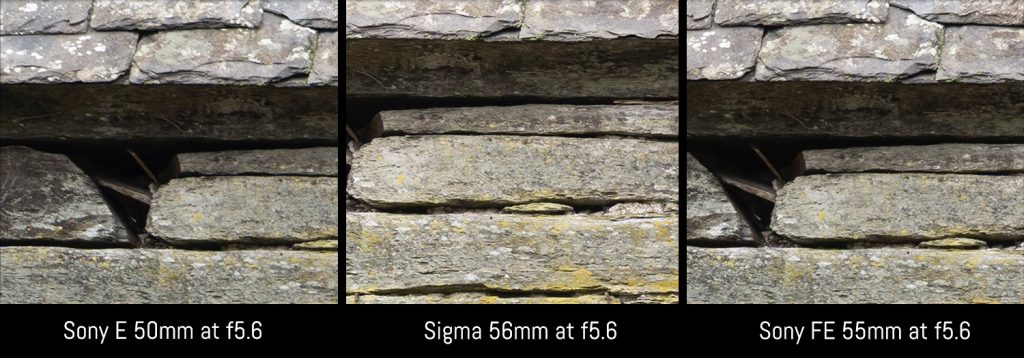
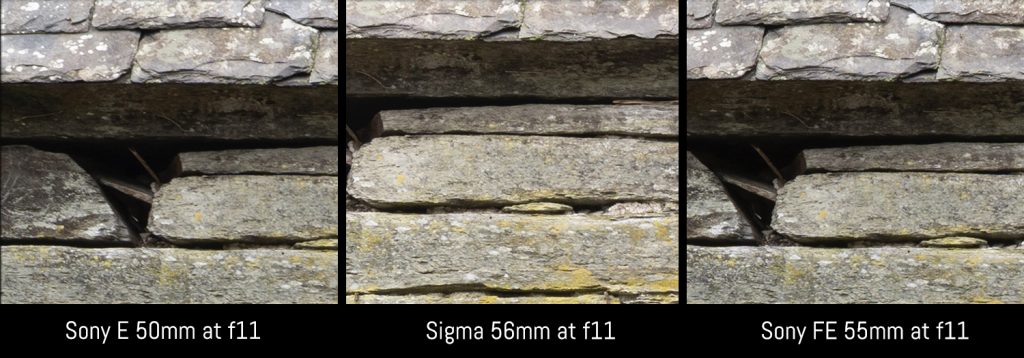
At a close focus distance, we can see that the 56mm is a little sharper than either Sony lens at their respective fastest apertures.
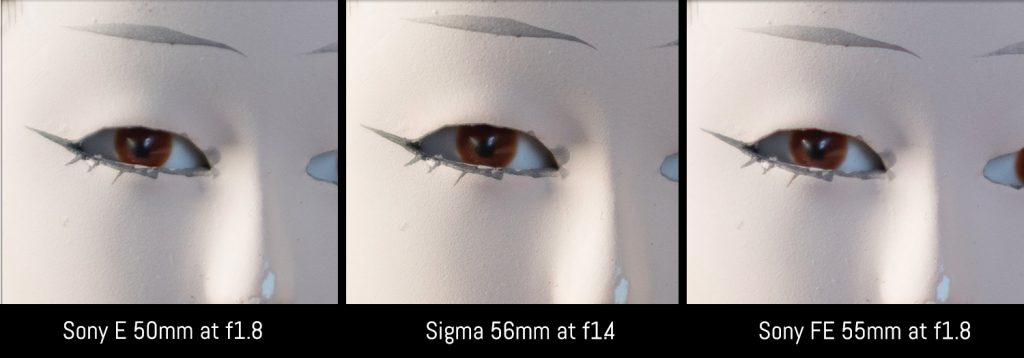
At f/2, the first value they all share, the 56mm is much sharper than its rivals.
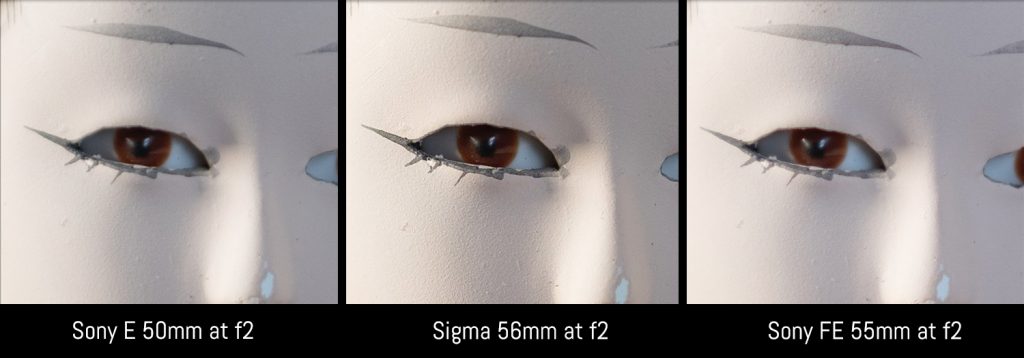
This trend continues until around f/5.6 where the three lenses look much more similar.

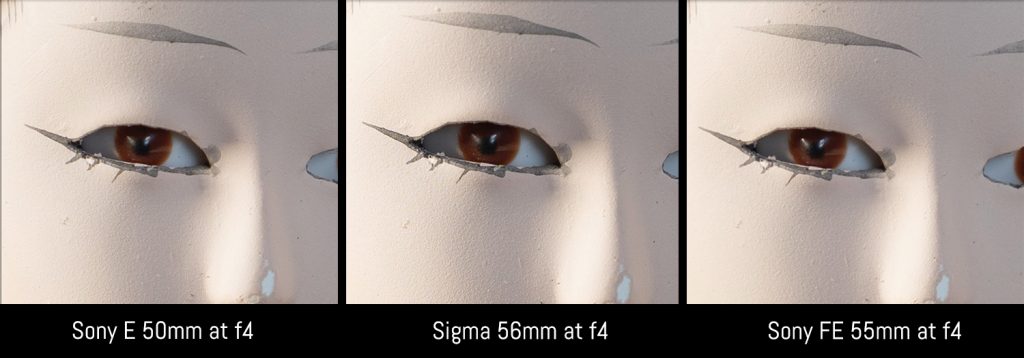
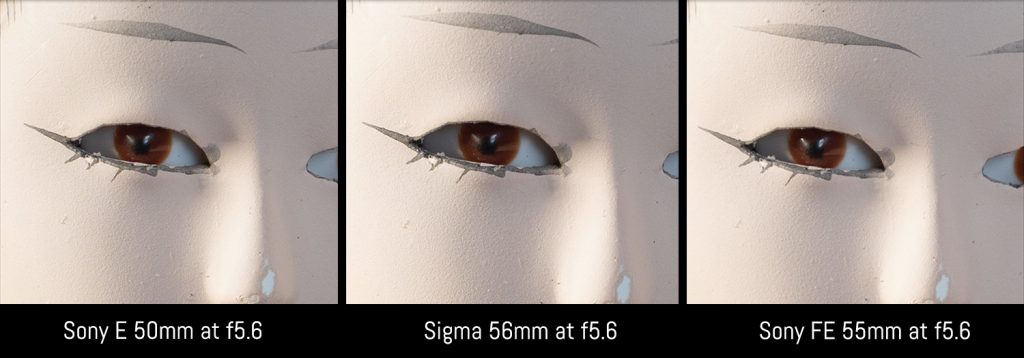
At f/8 and beyond, there isn’t a big difference between the three lenses. f/16 and f/22 are the only values I would avoid.
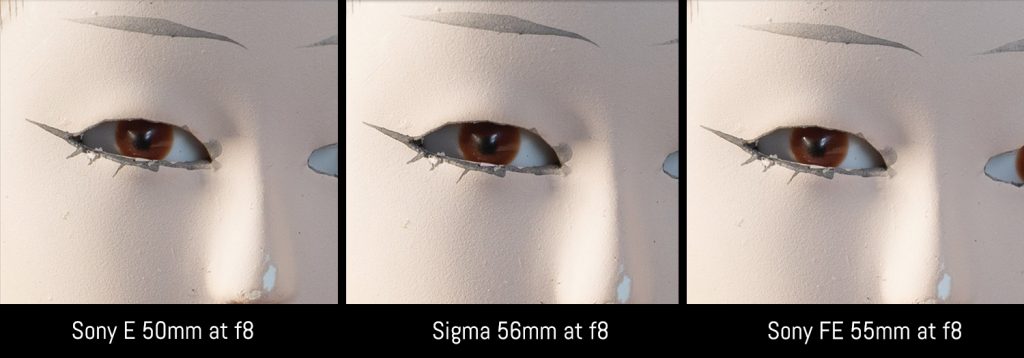
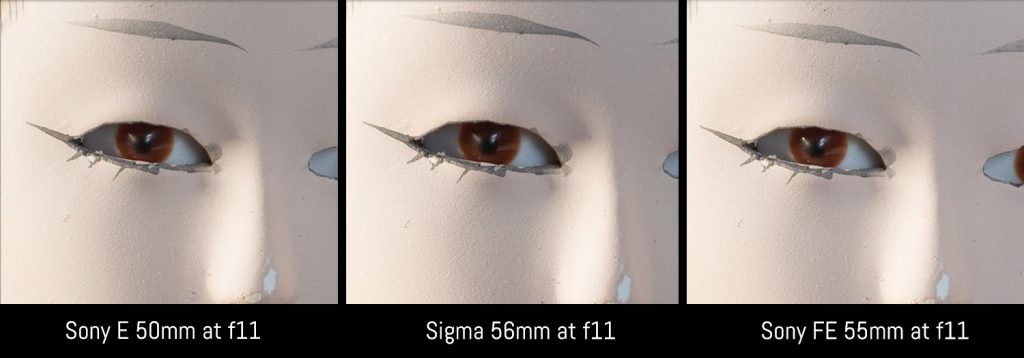
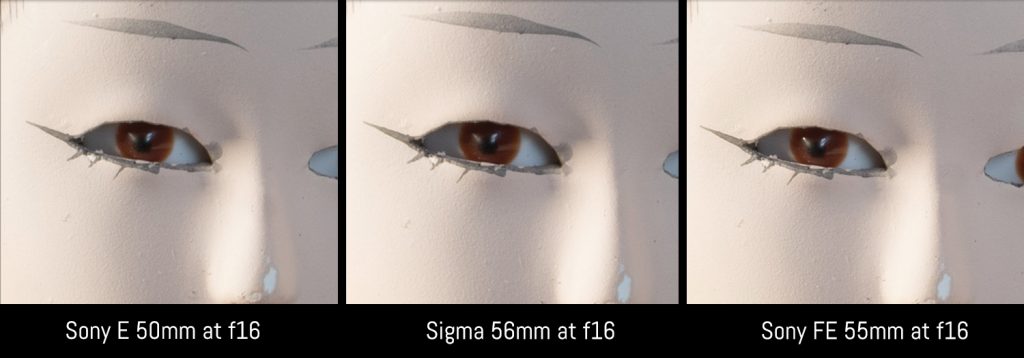
All things considered, the Sigma lens is the best performer of the three, except at a long focus distance wide open where the 55mm has a small advantage in both the centre and in the corners.
Bokeh and subject separation
‘Bokeh’ refers to the aesthetic quality of the background or foreground blur of an image, or in other words, the areas of the image that lie outside the depth of field.
When shot wide open, the bokeh balls of all three lenses are round at the centre but assume the familiar cat’s eye shape the closer they are to the edge of the frame. Those of the 55mm display a slightly stronger onion ring effect whereas the 56mm’s are larger thanks to the 1.4 aperture.
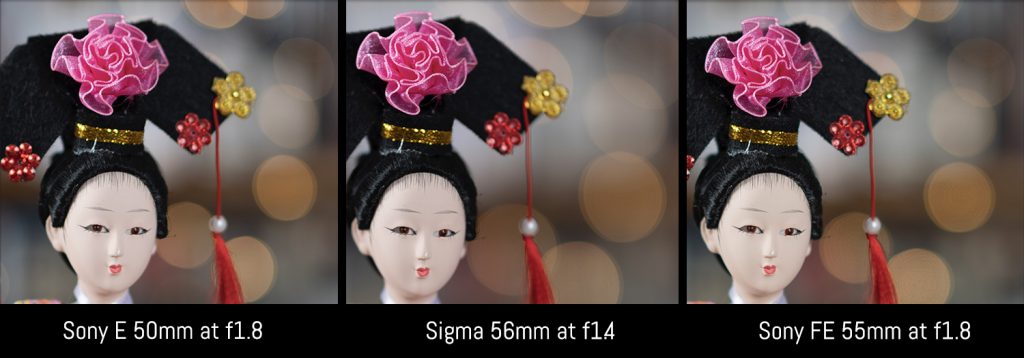
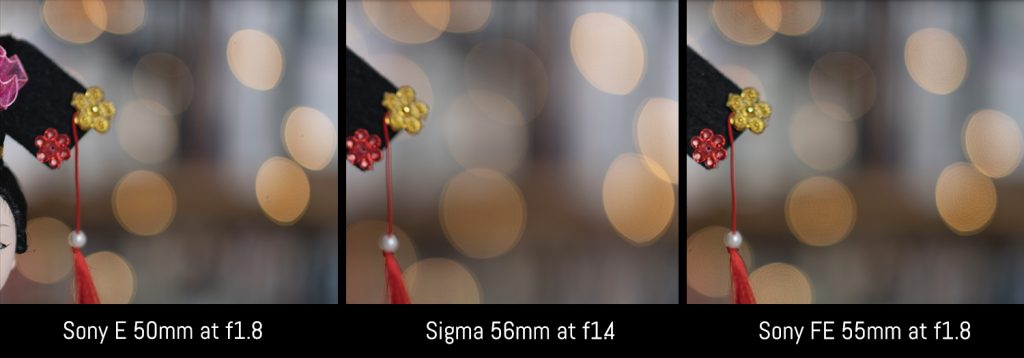
At f/2, the bokeh balls are practically identical. The 50mm’s aren’t quite as round and the 55mm’s continue to display some onion rings but otherwise, it isn’t easy to tell them apart.
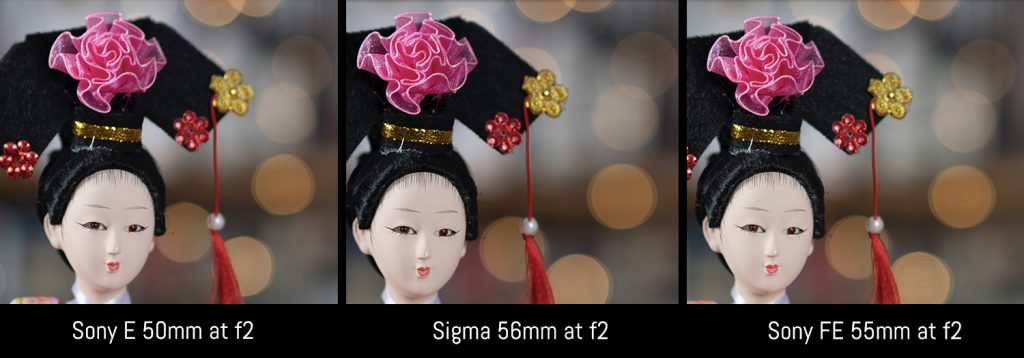
By f/2.8, the bokeh balls of all three lenses begin to assume the shape of the diaphragm.
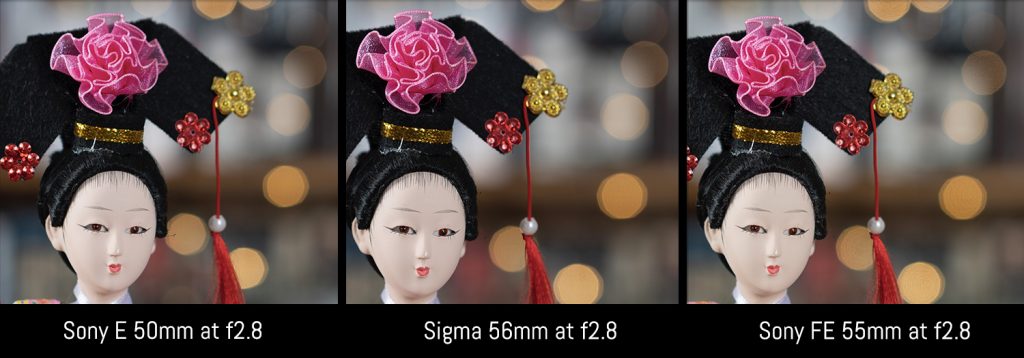
Looking at another set of examples taken wide open, we can see that the 50mm displays a little more fringing around the out-of-focus areas in comparison to the other two lenses. It also has the busiest bokeh of the three, followed by the 55mm and finally the 56mm. The 56mm’s is the most pleasant thanks to its smooth and buttery appearance.
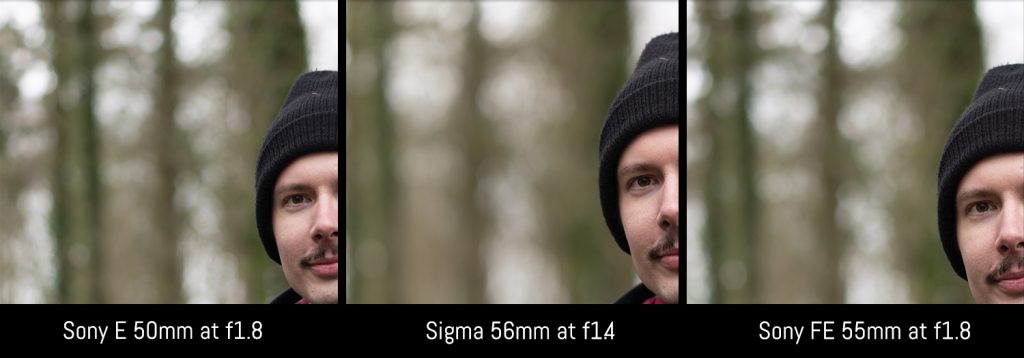
Subject separation can be best achieved with the 56mm, not only thanks to its faster aperture but also because it has the longest focal length of the three. That said, the 55mm and 50mm are almost as capable, and all that’s required to achieve a similar effect is to move a little closer to your subject.



Flare
The 55mm is much more resistant to flare and ghosting than the 50mm, whereas the 56mm can sometimes produce flare but only at very specific angles. Below you can see the worst examples I encountered during my testing period. (The Sigma example was taken using the Micro Four Thirds version of the lens. I did encounter a similar example with the Sony but unfortunately I accidentally deleted it from the memory card.) You can reduce flare by purchasing a lens hood for the 50mm but it won’t disappear entirely if you shoot into bright light sources. With the lens hood attached, the 56mm shouldn’t produce any flare at all.
Chromatic aberration
All three lenses display evidence of fringing in areas of high contrast. In the case of the 50mm and 55mm, it is visible until around f/4 whereas the 56mm shows some mild traces until f/2.8. Of the three, the 55mm appears to suffer the most wide open. As always, you can combat chromatic aberration by applying the appropriate corrections to the RAW files in post-production.
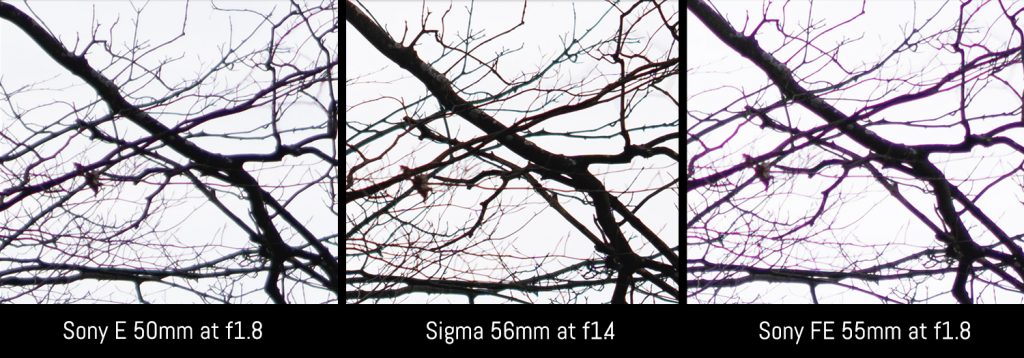
Distortion and Vignetting
Distortion and vignetting can be corrected in-camera by applying the appropriate lens corrections. If you are dealing with the RAW files however, you will need to activate the lens profile to correct these issues.
Without the lens profile, the 56mm displays very strong pincushion distortion and noticeable vignetting wide open as you can see from the examples below.
As for the two Sony lenses, you will once again encounter vignetting wide open without the lens profile but there is barely any distortion regardless of whether the profile is applied or not.
Minimum Focus Distance
One way in which the 50mm outperforms its rivals is in terms of its minimum focus distance. As you can see, you can get a little closer to the subject with the 50mm than with the 56mm, and quite a bit closer than with the 55mm. None of them are macro lenses by any means but it’s nice to know that close-up work isn’t an impossibility.
Field of view
The three lenses in this article all have different focal lengths, so it is natural for them to have a marginally different field of view as well. We can see how these differences play out in the real world by observing the three images below. (The camera was on a tripod, so the distance between the camera and Mathieu did not change between shots.) Whereas the examples taken with the 55mm and 56mm look quite similar, Mathieu appears to be further away in the example taken with the 50mm.
Stabilisation
Of the three lenses, only the E 50mm f/1.8 comes with OSS (Optical Steady Shot), which is Sony’s version of optical stabilisation. If you own a Sony camera that lacks in-body stabilisation such as the a6300 I used for most of these test shots, you will find that having a lens with OSS is quite useful, especially in low-light situations where slower shutter speeds are necessary.
In our tests with the a6300, we found it was possible to take sharp shots down 1/5s but we had better luck between 1/10 and 1/15s.

In the case of stabilised bodies such as the a6500, the camera uses 3 axes on the sensor and 2 axes on the lens to produce a combined 5-axis stabilisation system. Our review of the camera revealed that combining optical and in-body stabilisation doesn’t provide a tangible advantage over optical stabilisation on its own. For this reason, it wasn’t a surprise that we were only able to manage a slightly better result of 1/4 of a second with the Sony 50mm.

Autofocus performance
In single AF, all three lenses perform very well provided that the light conditions are good. In darker conditions or situations lacking contrast, it takes them longer to lock onto a subject and you may encounter some hunting. Note that this behaviour can also vary depending on the camera and how recent its autofocus system is.
In continuous AF, the Sonys seem to be a little more reactive than the Sigma. This is especially true for video where the 56mm occasionally struggles to lock onto a subject even if the contrast and light are favourable. However it is worth mentioning that the Sigma lens, like the two Sonys, is fully compatible with Sony’s hybrid AF system unlike some of the older Sigma APS-C lenses. This means you can track your subject wherever it moves within the frame.
All three lenses are extremely quiet. In the case of the two Sonys, you can hear the motor whirring faintly if you put you ear close to the lens whereas the Sigma is deadly silent.
Manual focusing
Finally we come to manual focusing. All three lenses feature a fly-by-wire focus ring complete with grooves along the surface to make them easier to hold and turn. That of the Sigma is the most enjoyable to use from a purely tactile perspective, not only because the grooves are deeper but also because its rubberised texture isn’t as cold to the touch.
In use, all three are precise and easy to use. The 50mm’s ring is flimsier and spins more freely than those of the 55mm and 56mm but this didn’t impede my ability to focus properly with it.
Conclusion
All things considered, the Sigma 56mm f/1.4 really is an exciting addition to the Sony APS-C lens range. It is around half the price of the Sony FE 55mm f/1.8, yet has a faster aperture and delivers superior sharpness except for at the widest apertures at a long focus distance. The quality of the out-of-focus rendering is a little more pleasant than the two Sonys and the autofocus speed, though not quite as snappy, is fully compatible with Sony’s PDAF system.
Now, I’m a longtime owner and fan of the Sony 55mm, but I have no problem saying that I would buy the Sigma in a heartbeat were I faced with buying my first 85mm equivalent lens for Sony APS-C today. The biggest advantage of the 55mm is that it also covers Sony full-frame sensors, so if you are a user of both systems, it is quite the versatile prime to have in your collection.
As for the Sony 50mm, it makes sense if you are on a tight budget. The quality is good enough, and it comes with an important feature that neither the 55mm nor the 56mm has: optical image stabilisation.
Choose the Sigma 56mm f/1.4 if you:
- want the best quality possible at an affordable price
Choose the Sony E 50mm f/1.8 if you:
- want to spend as little as possible on a portrait lens
- use a non-stabilised body such as the a6300 and often work in poor light conditions
Choose the Sony FE 55mm f/1.8 if you:
- also own a full-frame Sony camera
You may also be interested in:
- Sony E 50mm f/1.8 vs Sigma 60mm f/2.8 DN A
- Sigma 19mm f/2.8 DN Art vs Sony E 20mm f/2.8
- Sony FE 50mm f/1.8 vs FE 55mm f/1.8
- Samyang AF 50mm f/1.4 vs Sony FE 55mm f/1.8
Sample Images
Sigma 56mm f/1.4


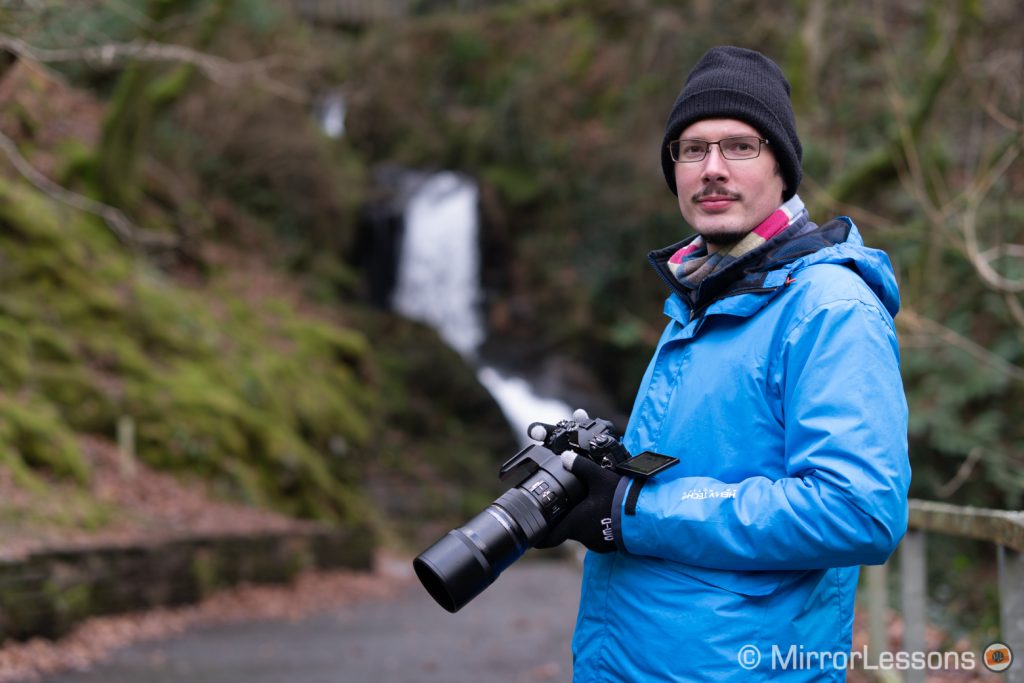




Sony 50mm f/1.8








Sony FE 55mm f/1.8









Reminder: the links below are affiliate links. If you decided to buy something after clicking the link, we will receive a small commission.
Check the price of the Sigma 56mm f/1.4 on
Amazon UK | Amazon | B&H Photo
Check the price of the Sony E 50mm f/1.8 on
Amazon UK | Amazon | B&H Photo
Check the price of the Sony FE 55mm f/1.8 on

